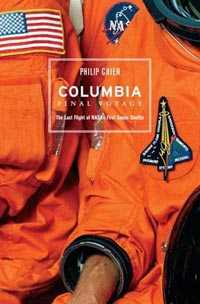Review: Columbia—Final Voyageby Jeff Foust
|
| In terms of explaining the mission itself, Columbia—Final Voyage is unparalleled, and unlikely to be equaled given the sheer amount of information Chien has compiled. |
To say that Chien exhaustively examines the STS-107 mission might be a bit of an understatement. The first part of Columbia—Final Voyage goes into detail about the crew and other people involved in the mission, with each astronaut getting a chapter-long biography. That’s followed by the long run-up to the mission’s eventual launch. The core of the book is part 3, where each day of the mission itself is dissected in deep detail, from the specific experiments the crew worked on to the wake-up music played by mission control twice each day (the STS-107 crew split into two shifts to allow them to work around the clock.) Chien then recounts minute-by-minute the accident itself, and the investigation that followed. However, the investigation gets far less attention than the mission: the formation of the Columbia Accident Investigation Board (CAIB), for example, doesn’t come up until less than 100 pages from the end of the book. For a fuller account of the investigation, readers should consider the 2004 book Comm Check… by Cabbage and Bill Harwood (See “Reviews: Columbia plus one year”, The Space Review, February 16, 2004.)
In terms of explaining the mission itself, Columbia—Final Voyage is unparalleled, and unlikely to be equaled given the sheer amount of information Chien has compiled. (More information, including photos, audio, and video, is available on a separate CD-ROM (not reviewed here) available for sale on the author’s web site, which itself has additional multimedia content not included in the book.) Sometimes it may seem like there’s too much information: do we really need to know, for example, what Kalpana Chawla ate for her first meal in space on a mission preceding STS-107? Chien can be a little repetitive too: on page 187 he uses an analogy—a piece of paper quickly slowing down after being tossed out of a moving car—to explain how the chunk of foam that fell of Columbia’s external tank quickly decelerated; the same analogy, with almost the exact same wording, is used just nine pages later.
Chien singles out many people for criticism surrounding STS-107, but perhaps none quite so strongly as the media. In a tone that edges on bitterness, he notes that only a few reporters—himself included—covered STS-107 while the shuttle was in orbit, only to have the media descend en masse on the Kennedy Space Center and other NASA facilities in the aftermath of the accident. In several cases he criticizes the media for their lack of knowledge about the mission and the shuttle program in general, or simply for some of the actions they took (like a Jacksonville, Florida TV station that sent reporters to KSC immediately after the accident to do live reports even though they “had not bothered to cover NASA activities for the last decade”). While ideally reporters should have been better informed about NASA and STS-107 prior to the accident, it’s not clear that they acted any differently in the wake of the accident than they have in recent years for other sudden disasters, from terrorist attacks to hurricanes to mining accidents.
If the perception that Columbia is fading from our collective consciousness far faster that the Challenger accident or even Apollo 1 is true, it would be ironic, since Columbia may end up being far more influential over the long term that than the other two manned spaceflight accidents suffered by NASA to date. Apollo 1 did not cause NASA to surrender its quest to land humans on the Moon, and Challenger, while triggering some long-term changes in national launch policy, did not lead to the end of the shuttle or then-nascent space station program. Yet the loss of Columbia and its crew was the flash point that started a long-needed overhaul of the nation’s space program, resulting in less than a year in a new Vision for Space Exploration that marked the beginning of the end of the shuttle and the start of a new quest to return humans to the Moon. Columbia’s long-term importance, then, will be tied to the ultimate success or failure of the Vision, but regardless, Columbia—Final Voyage reminds us that the accident that has reshaped the American space program was not an abstract event but rather a tragic end to a mission involving hard-working astronauts trying to extend the frontiers of science.
